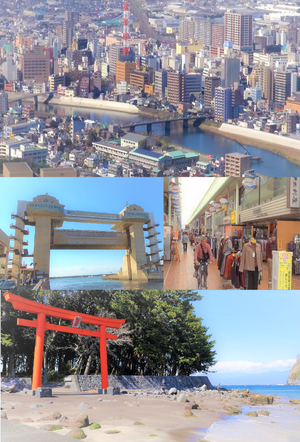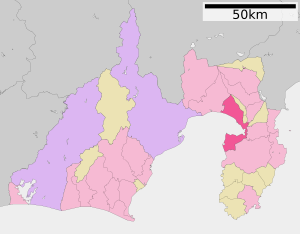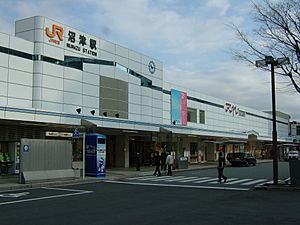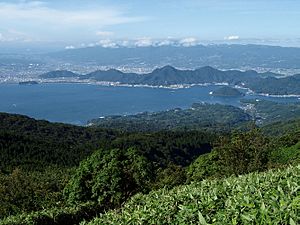Numazu facts for kids
Quick facts for kids
Numazu
沼津市
|
|||
|---|---|---|---|

City center, Byuo,Numazu Nakamise Shopping Street,Torii in the Heda area
|
|||
|
|||

Location of Numazu in Shizuoka Prefecture
|
|||
| Country | Japan | ||
| Region | Chūbu (Tōkai) | ||
| Prefecture | Shizuoka | ||
| Area | |||
| • Total | 186.96 km2 (72.19 sq mi) | ||
| Population
(December 1, 2019)
|
|||
| • Total | 189,486 | ||
| • Density | 1,013.511/km2 (2,624.98/sq mi) | ||
| Time zone | UTC+9 (Japan Standard Time) | ||
| - Tree | Pine | ||
| - Flower | Crinum asiaticum | ||
| - Bird | Common gull | ||
| Phone number | 055-931-2500 | ||
| Address | 16-1 Miyukichō, Numazu-shi, Shizuoka-ken 410-8601 | ||
Numazu (沼津市, Numazu-shi) is a cool city located in eastern Shizuoka Prefecture, Japan. As of December 2019, about 189,486 people lived there. The city covers an area of about 187 square kilometers (72 square miles).
Contents
Discover Numazu's Geography
Numazu is found at the northwestern tip of the Izu Peninsula. This area is a popular spot for fun and relaxation. It's famous for its many hot springs. On clear days, you can even see Mount Fuji, Japan's tallest mountain, from Numazu!
The city is about 130 kilometers (80 miles) west of Tokyo. It's also on the Tōkaidō Main Line, which is a major railway connecting Osaka to Tokyo.
Climate and Rivers
Numazu has a warm climate because of the Kuroshio Current. This means it has hot, humid summers and mild, cool winters. The Kano River flows right through the middle of the city. The highest point in Numazu is Mount Ashitaka, which is 1,188 meters (3,898 feet) tall.
Nearby Cities and Towns
Numazu is surrounded by several other places in Shizuoka Prefecture:
Numazu's Population Over Time
The number of people living in Numazu has slowly gone down over the last 30 years.
| Historical population | ||
|---|---|---|
| Year | Pop. | ±% |
| 1960 | 163,581 | — |
| 1970 | 194,274 | +18.8% |
| 1980 | 208,708 | +7.4% |
| 1990 | 216,213 | +3.6% |
| 2000 | 211,559 | −2.2% |
| 2010 | 202,283 | −4.4% |
A Look at Numazu's History
Numazu is a very old place with a long history. It was first mentioned in records from the Nara period. Back then, it was an important capital.
Edo Period Growth
During the Tokugawa shogunate, Numazu became a separate area called Numazu Domain in 1777. The city grew a lot during the Edo period. This was because it was located on the Tōkaidō highway. This highway connected the big cities of Edo (now Tokyo) and Kyoto. Numazu had two important post stations where travelers could rest.
Modern Numazu Develops
After the Meiji Restoration, the Numazu Station opened in 1889. Numazu became known as a health resort because of its seaside location. In 1893, Emperor Meiji even had an imperial villa built there. Many important people, like nobles and writers, also liked to visit.
Numazu officially became a city on July 1, 1923.
Challenges and Growth
In 1926, a large fire destroyed the center of Numazu. During World War II, the city was heavily damaged by bombing on July 17, 1945.
After the war, Numazu grew by merging with nearby villages. In 2000, the government made Numazu a Special City (特例市, Tokurei-shi). This gave the city more power to make its own local decisions. In 2005, the village of Heda also joined Numazu. In 2007, Numazu hosted the 29th WorldSkills International Championship, a big event for skilled trades.
Numazu's Economy and Jobs
Numazu is an industrial city and a financial hub for the region. Its port is very important for commercial fishing in Shizuoka Prefecture.
Fishing and Farming
Numazu is famous for producing more dried Japanese horse mackerel than anywhere else in Japan. The city makes about half of the country's total!
Farming is also important. Farmers mainly grow mandarin oranges and green tea. They also produce Brussels sprouts, dairy products, and rice.
Banking and Business
Several banks have their main offices in Numazu. These include Suruga Bank, Shizuoka Chuo Bank, and Numazu Shinkin Bank.
Education in Numazu
Numazu has many schools for students of all ages.
Public Schools
The city government runs 24 public elementary schools and 17 public middle schools. There is also one public school that combines middle and high school. The Shizuoka Prefectural Board of Education operates four public high schools.
Private and Special Schools
Numazu also has one private elementary school and one private combined middle/high school. There are five private high schools. For students with special needs, the prefecture runs three special education schools in Numazu.
Getting Around Numazu
Numazu has good transportation options, especially by train and highway.
Train Travel
You can travel by train using the Central Japan Railway Company.
- Tōkaidō Main Line: Numazu - Katahama - Hara
- Gotemba Line: Numazu - Ōoka
Major Highways
Several important highways pass through or near Numazu:
 Tomei Expressway
Tomei Expressway Shin-Tōmei Expressway
Shin-Tōmei Expressway Izu-Jūkan Expressway
Izu-Jūkan Expressway National Route 1
National Route 1 National Route 246
National Route 246 National Route 414
National Route 414
Fun Things to Do in Numazu
Numazu is a great starting point for exploring famous places like Mount Fuji, Hakone, and the Izu Peninsula. These are all major tourist spots!
Waterfront Fun
The harbor area has many seafood restaurants where you can enjoy fresh catches. There's also a special anti-tsunami barrier with an observation deck on top. From here, you can see amazing views of the city and the surrounding area. Close to the main train station, you'll find a lively shopping street.
Numazu has the longest coastline of any city in Shizuoka Prefecture. The Senbonhama ("Thousand Tree Beach") is a beautiful seaside spot. It's known as one of the best places to see Osezaki, Nihondaira, or the southern Japan Alps. These views are even better with the background of Sembonmatsubara and Mount Fuji.
Aquariums and History
Numazu is home to three aquariums where you can see amazing sea creatures:
- Mito Sea Paradise
- Awashima Marine Park
- Numazu Deepblue Aquarium
Historical Sites to Explore
You can also visit some interesting historical places:
- Nagahama Castle ruins
- Kōkokuji Castle ruins
- Yasumiba Archaeological Site
Numazu's Sister Cities
Numazu has special friendships with cities in other countries and in Japan:
 Kalamazoo, Michigan, United States, since 1963
Kalamazoo, Michigan, United States, since 1963 Yueyang, Hunan, China, since 1985
Yueyang, Hunan, China, since 1985 Ueda, Nagano, Japan
Ueda, Nagano, Japan
Famous People from Numazu
Many talented people have come from Numazu:
- Tomita Tsunejirō (1865–1937) – an early student of judo
- Nobutaka Machimura – a politician
- Shinji Ono – a professional soccer player
- Masakuni Yamamoto – a professional soccer player
- Kento Sugiyama – a professional baseball player
- Kyoko Iwasaki – an Olympic medalist in swimming
- Koji Murofushi – an Olympic medalist in hammer-throw
- Miu Hirano – a Table Tennis player
- Yamada Nagamasa – a merchant and adventurer from the Sengoku period
- Norio Ohga – a former CEO of Sony
- Tomoyoshi Murayama – an artist and playwright
- Masato Harada – a movie director
- Ulka Sasaki — a mixed martial artist
See also
 In Spanish: Numazu (Shizuoka) para niños
In Spanish: Numazu (Shizuoka) para niños








